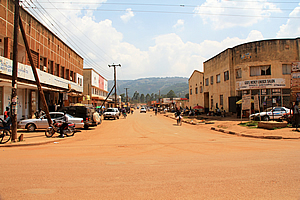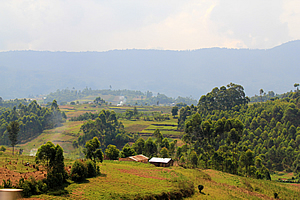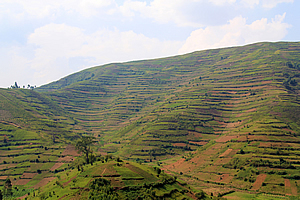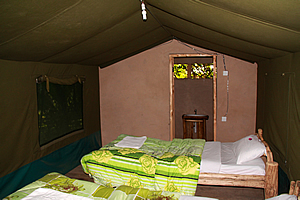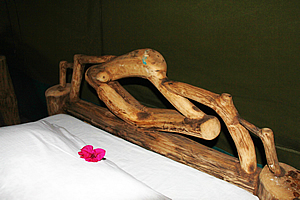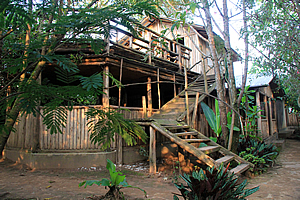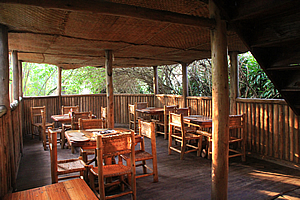|
||||||||||||||||||
|
||||||||||||||||||
Home > Treks > Outside Australasia > Bwindi Gorilla Trek > 1 |
||||||||||||||||||
|
||||||||||||||||||
Introduction to today's journeyIt is a rough road that leads to the heights of greatness. - Lucius Annaeus Seneca Today's trek takes our group into the remotest corner of Uganda over precarious mountain roads. Today's JourneyDistance trekked today: 0.0 kilometres. Total distance trekked to date: 0.0 kilometres. I HAVE been travelling westward from Kampala for several days now. Until now the road across Uganda had been in good condition, but now the western border to Rwanda and the Democratic Republic of Congo was near, it was obvious we were heading into remote territory.
Upon leaving the small dusty city of Kabale we followed the main road along the bottom of the wide valley before turning off to the left. This road quickly departed the valley and started ascending into the mountains. The rolling hills of fields of tea quickly gave way to steeper rounded mountains with hedged terraces of small fields spreading out in an enormous patchwork over the mountains. The terraces roughly followed the contours of the mountains. Small houses with bright shiny corrugated iron roofing dotted these mountains randomly spread from their summits down to the valley below. The road tightly wound around the mountains negotiating passes and valleys galore. In between the passes the road mostly clung precariously to the sides of the mountains. The houses we did pass close by were dirty looking mud brick houses mostly with people sitting or standing outside of them. Most were perched on the ridges. Perhaps this was because there was less chance of them being affected by erosion than in the gullies. Many people were walking along the road, some herding small flocks of animals. Most were carrying baskets of produce on their heads. There were no other vehicles on the precarious road.
Eventually we turned off the main road onto a narrow gravel road which continued winding around the mountains. The road was quite rough – African massage material. It was rather narrow forcing us to be precariously close to the steep drop below us. The road wound around going continuously uphill never reaching the tops of the increasingly high mountains with rounded summits. The main valleys below us were either steep gorges or lakes. Perhaps the lakes had been blocked by large landslides. Most of the mountainsides were covered in the small terraced paddocks where vegetables grew. It was evident though that until fairly recently this had all once been forest. There were numerous slips that had come down on the road in storms past, but fortunately these had all been cleared. The only thing holding these vegetable plots onto the sides of the mountains were wooden fences that had over the years sprouted into trees. Some of these fences were almost new and only had the first shoots sprouting off them. Others were now rows of trees that had grown to around ten metres tall. These tree fences lined each side of the road to minimise erosion, but it was clear the slopes of these mountains were very unstable.
Occasionally we encountered a cow wandering along the road. Perhaps it was there deliberately to keep the grass of the verges down, or maybe it had escaped the confines of its paddock. A car overtook us. This was the first car we had encountered on this narrow road. Our driver Jeremiah had to pull over to let them pass. For the following ten minutes we were choking on the dust the back wheels were kicking up before it got too far ahead to be of any problem to us anymore. The mountains were somewhat obscured by a thin haze washing much of the colour out of them. The rounded mountains towered high to around three thousand metres. We were getting close to the main dividing range now, the boundary between Uganda and the Democratic Republic of Congo. We continued passing numerous houses along the sides of the road, each house perched against the edge of the mountains ready to slip away at the next big storm. There were a lot of people around the houses, and groups of grubby children waved out to us, many yelling “hello”, and some yelling “money”. Some ridges or gullies had entire villages of tiny dilapidated houses clustered close together. As we travelled further and further along the road, the quality of the houses continued to decline to appalling standards, and yet everyone we passed seemed happy. Most people were dressed in rags, though some of the women wore very nice dresses and the occasional man wore a suit – albeit worse for wear. We had climbed to almost three thousand metres above sea level when the road finally topped out and began to descend. By now there were clear views of many mountains, though all were still very rounded on top. Many of these mountains were now forested, indicating we were close to our destination. Even the hills that weren’t forested had large trees on them indicating the forest had recently covered them. The road steeply descended to a bridge over a small river. We must be near the head of the valley and therefore close to the border. We had reached the Bwindi Impenetrable Forest. Once across the narrow bridge, the road steeply climbed uphill. The quality of the road was even less than before and the mountainsides steeper than ever. Most of these mountainsides still had small plots of vegetables growing on them, but how they managed to stayed there defied gravity. Cliffs were appearing along the sides of the mountains now, but somehow the vegetable plots came almost up to them. We went higher and higher around precipitous ridge and gully, before briefly descending into a small village – the last outpost in the most remote corner of Uganda. The village was a dirt road with numerous derelict shops lining each side of the street. As we continued further, some of the shops appeared quite new, though still traditionally constructed. Then we suddenly turned off onto a short driveway past a couple of houses to the Wagtail Eco Safari Camp, where we will be based for the next three nights. The van parked in a small car park just inside the entrance of the Wagtail Eco Safari Camp in a remote corner of Western Uganda. The park was surrounded by small jungle trees. A man named Innocent introduced himself and after taking our bags out, he led us through a gap in the bushes to a small outside reception area in a timber pole building. We put down our bags and sat on the timber sofas while he checked us in. Turns out he was the unassuming owner of the ecolodge, but he preferred to only be known as "the guide". Innocent introduced us to Emma (strange name for a man I thought...). He will be the main cook during our stay. Once checked in Innocent led us to our tents where we will be based over the following two nights.
My tent was at the end of the ecolodge. The encroaching forest made it feel very remote yet it was still only two minutes walk from the main building. The tent was pitched on a large wooden slat platform some three by seven metres. The entire platform was stacked on piles made from four layers high of bricks. The tent was positioned over the back two thirds of the platform with a large fly held up by steel poles covering the tent and the front of the platform. I unlocked the front entrance of the tent and walked inside. There were two single beds constructed from knotted logs with nice mattresses and soft green bedding. There were a few flower petals placed on each bed for added effect. The logs used to make the bed heads were very twisted and knotted to amazing effect.
Beyond the bedroom was a partitioned off area with stone and concrete walls. To the right was the shower, to the left was the toilet and in the centre was a washing basin mounted on a rustic wooden cabinet. A solid slat timber door allowed access. The rendered walls rose to about two metres before being open to the elements for about fifteen centimetres to the ceiling. I could see out into the jungle but no one outside would have been tall enough to be able to see in. The floor and shower wall had flat rocks set into it. To my surprise there was a single florescent bulb hanging from the top of the main tent. I had not seen any evidence of electricity in the last two hours of traveling along the gravel road since shortly after leaving Kabale. We were in a very remote area. The safari lodge generated its own electricity through a diesel generator, and only operated between 5:00 and 7:00 AM and 7:00 and 11:00 PM. Otherwise there was no electricity here. There were one or two other eco lodges within an hour’s drive each with its own diesel generator, but otherwise there was no electricity at all around here.
The eco lodge was constructed very elaborately from timber logs. A log staircase ran out the outside to an upstairs deck. Downstairs there were no windows. The vertically set log walls ran up to half way up the walls. The top halves of the walls were open to provide an unbroken view into the jungle. The furniture was fittingly rustic knotted log construction in the communal areas and inside the tents where we stayed. Each piece of furniture appeared very elaborate until you sit or lie in them. The chairs were the most uncomfortable I have ever sat in, and the beds were pretty bumpy. Obviously the fine balance between aesthetics and functionality weren’t quite happening. The jungle surrounding the lodge and tents had obviously been planted as there wasn’t as much chaos as you would expect in a jungle. There were rows of clemanthe and the occasional banana tree planted in for good measure. The plants were also well maintained. However the jungle effect here was very effective.
Inside the dining hall were four heavy wooden tables each having four heavy wooden chairs around it. The roof was held up by timber logs around the outside and two in the middle. An internal wooden stairway rose up onto the deck above the ceiling. At the end of the dining room near the entrance was a dark bar. Behind that was the kitchen and further behind was the reception area we had initially entered. The front entrance came in through a small porch. Dinner finally arrived. We started with a very nice chicken vegetable soup. This was followed by beef, rice and a vegetable stew. Dessert was a nice assortment of diced fruit. I was going to be very well looked after here. |
||||||||||||||||||
|
||||||||||||||||||

